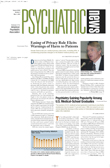While the famed Philadelphia Museum of Art dominates that city’s art scene, several smaller museums boast collections of which most world-class cities would be proud. Art lovers who attend APA’s annual meeting in May will thank themselves if they block out some time to visit one or more of them.
One of these treasures is the Barnes Collection, housed in a French provincial mansion just outside the city in Merion, Pa. Physician and entrepreneur Albert Barnes made a fortune from an antiseptic called Argyrol that he and a partner invented in 1902 and used that money to begin his art collection. He founded the Barnes Foundation in 1922 to oversee his growing collection.
Today the Barnes Collection is a leading repository of Impressionist and Post-Impressionist works, headlined by 180 Renoirs and 69 Cézannes. When the facility closed for a major renovation in 1993, the foundation sent dozens of the collection’s star attractions on tour for the first time, giving art aficionados around the world who had not visited the museum an opportunity to sample the riches it contains.
Many of the paintings are displayed next to furniture, household objects, and crafts. While such an array may be at first visually jarring, it fits with Barnes’s philosophy that beautiful lines and other elements that comprise a great painting are universal and thus visible in objects not considered to be works of art.
Throughout his life Barnes displayed an affinity for people on the lower end of the socioeconomic ladder and a dislike of those who inherited their privileges. To demonstrate his strong belief that all people should have the opportunity to enjoy fine art, he installed many of the paintings he purchased in his factories in the early years of the 20th century and then organized discussion groups so the factory workers could discuss the art works.
Barnes was also a strong, public advocate for equal rights for African Americans. His death in 1951 triggered a provision of his will in which he gave control of the Barnes Foundation to historically black Lincoln University.
The Barnes Collection is located at 300 Latch’s Lane in Merion and, for those without a car, is accessible by local train or bus from Center City. Reservations are recommended for weekend visits since the foundation limits access to 200 people on Friday and Saturday and 100 on Sunday.
Annual meeting goers who are fascinated by what sculptors can create out of clay or bronze also have a don’t-miss attraction awaiting them in Philadelphia. With 124 sculptures, the Rodin Museum is the largest repository of works outside of Paris by one of the world’s greatest sculptors, Auguste Rodin.
The first work visitors encounter is Rodin’s famous “Gates of Hell,” which the artist worked on for 37 years and contains figures of more than 100 humans and other animals. Also familiar from many an art textbook are “The Kiss” and “The Burghers of Calais,” as well as Rodin’s famous sculpture of French novelists Honoré de Balzac. The museum also houses drawings, prints, letters, and plaster studies by Rodin.
Just a few blocks from the convention center is the Pennsylvania Academy of Fine Arts. Housed in an 1876 building that is a melange of architectural styles, the academy is the oldest art institution in the United States. It was founded in 1804, when Philadelphia was America’s wealthiest city. Many of the stars of its collection are works by America’s renowned painters, including Gilbert Stuart, Winslow Homer, Andrew Wyeth, and various members of the Peale family. In May, as happens every year, the academy’s school takes over all the exhibition space to display the works of its students.
The cultural heritage of several of the population groups in the ethnic mix that is the City of Brotherly Love also have dedicated museums. Standouts among these are the African American Museum, the National Museum of American Jewish History, and the American Swedish Museum.
In South Philadelphia, whose Italian heritage is still strong, there is also a museum devoted to famed opera singer and actor Mario Lanza, who was raised in that neighborhood. It’s erected on the site of the building where Lanza, whose heritage was half Italian and half Spanish, took his first music lesson.
If art, sculpture, and ethnic heritage seem a little too mainstream a museum diet, how about a couple of museum outliers impossible to find in your hometown? The Mummers Museum, for example, commemorates the history and pageantry of the groups who dance in astoundingly elaborate costumes in the annual New Year’s Day Mummers Parade.
And then there’s the Mutter Museum, for those who develop a yen to see a collection of preserved human oddities, most of them dating to the 1850s and collected by a Philadelphia physician. Skeletons of giants and dwarfs are on display, as are preserved physiological specimens and medical instruments of that era. ▪
